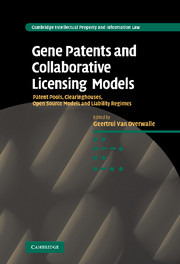 Gene Patents and Collaborative Licensing Models
Gene Patents and Collaborative Licensing Models Book contents
- Frontmatter
- Contents
- List of contributors
- Preface
- Foreword: Jean-Jacques Cassiman
- List of abbreviations
- Part I Patent pools
- Part II Clearinghouses
- 5 Clearinghouse mechanisms in genetic diagnostics. Conceptual framework
- 6 Case 3. The Global Biodiversity Information Facility (GBIF). An example of an information clearinghouse
- 7 Case 4. BirchBob. An example of a technology exchange clearing house
- 8 Case 5. The Public Intellectual Property Resource for Agriculture (PIPRA). A standard license public sector clearinghouse for agricultural IP
- 9 Case 6. The Science Commons Material Transfer Agreement Project. A standard licence clearinghouse?
- 10 Case 7. The collective management of copyright and neighbouring rights. An example of a royalty collection clearinghouse
- 11 Comment on the conceptual framework for a clearinghouse mechanism
- Part III Open source models
- Part IV Liability regimes
- Part V Different perspectives
- Part VI Summary and concluding analysis
- Index
- Titles in the series
10 - Case 7. The collective management of copyright and neighbouring rights. An example of a royalty collection clearinghouse
from Part II - Clearinghouses
Published online by Cambridge University Press: 14 January 2010
- Frontmatter
- Contents
- List of contributors
- Preface
- Foreword: Jean-Jacques Cassiman
- List of abbreviations
- Part I Patent pools
- Part II Clearinghouses
- 5 Clearinghouse mechanisms in genetic diagnostics. Conceptual framework
- 6 Case 3. The Global Biodiversity Information Facility (GBIF). An example of an information clearinghouse
- 7 Case 4. BirchBob. An example of a technology exchange clearing house
- 8 Case 5. The Public Intellectual Property Resource for Agriculture (PIPRA). A standard license public sector clearinghouse for agricultural IP
- 9 Case 6. The Science Commons Material Transfer Agreement Project. A standard licence clearinghouse?
- 10 Case 7. The collective management of copyright and neighbouring rights. An example of a royalty collection clearinghouse
- 11 Comment on the conceptual framework for a clearinghouse mechanism
- Part III Open source models
- Part IV Liability regimes
- Part V Different perspectives
- Part VI Summary and concluding analysis
- Index
- Titles in the series
Summary
Introduction
In a collective management system, owners of rights authorise collective management organisations to administer their rights – that is to negotiate with users, deliver licenses, collect fees and distribute them, and monitor unlicensed uses.
Copyright and neighbouring rights are exclusive rights and should normally be exercised individually by the owner of the right himself. But as early as the first half of the nineteenth century it appeared that certain rights, in the first place the right of public performance of musical works, could not in practice be exercised individually.
The number of venues at which musical performances took place and the number of copyright owners whose rights were involved were so large as to preclude altogether the possibility of individual negotiation between right owner and user. Performances by means of recordings and radio have multiplied the scale of the problem still further. In these circumstances the only feasible method of enforcing the performing right was the establishment of organisations capable of representing the rights of thousands of individual copyright owners and thus being in a position to negotiate with all music users.
Among the first organisations to have been established are the authors' societies SACEM (France, 1851), SIAE (Italy, 1882), GEMA (Germany, 1903) and PRS (United Kingdom, 1914).
At the outset, authors' societies represented their own national repertoire, but they rapidly entered into bilateral representation agreements with organisations of other countries and created a ‘worldwide web’, allowing any national organisation to license the use of, practically, the whole world music repertoire.
- Type
- Chapter
- Information
- Gene Patents and Collaborative Licensing ModelsPatent Pools, Clearinghouses, Open Source Models and Liability Regimes, pp. 151 - 160Publisher: Cambridge University PressPrint publication year: 2009
